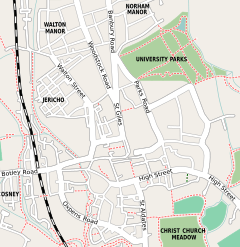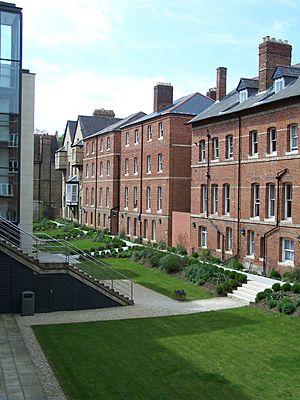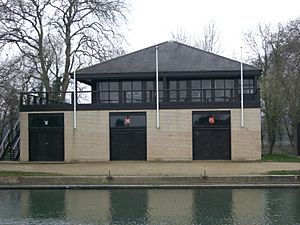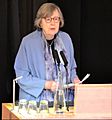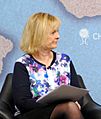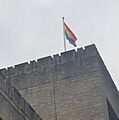St Anne's College, Oxford facts for kids
Quick facts for kids St Anne's College |
||||||||||||||||||||
|---|---|---|---|---|---|---|---|---|---|---|---|---|---|---|---|---|---|---|---|---|
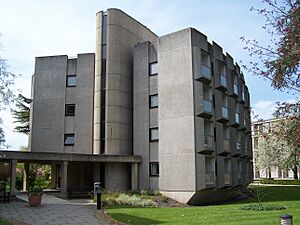
Wolfson Building, St Anne's College
|
||||||||||||||||||||
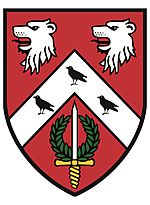
Blazon: Gules, on a chevron between in chief two lions heads erased argent, and in base a sword of the second pummelled and hilt or and enfiled with a wreath of laurel, three ravens, all proper
|
||||||||||||||||||||
|
|
||||||||||||||||||||
| University | University of Oxford | |||||||||||||||||||
| Location | Woodstock Road and Banbury Road | |||||||||||||||||||
| Coordinates | 51°45′44″N 1°15′43″W / 51.762123°N 1.261974°W | |||||||||||||||||||
| Latin name | Collegium Sanctae Annae | |||||||||||||||||||
| Motto | Consulto et audacter (Purposefully and boldly) |
|||||||||||||||||||
| Established | 1879 | |||||||||||||||||||
| Named for | Saint Anne | |||||||||||||||||||
| Previous names | The Society of Oxford Home-Students (1879–1942) The St Anne's Society (1942–1952) |
|||||||||||||||||||
| Sister college | Murray Edwards College, Cambridge | |||||||||||||||||||
| Principal | Helen King | |||||||||||||||||||
| Undergraduates | 444 | |||||||||||||||||||
| Postgraduates | 250 | |||||||||||||||||||
| Mascot | Beaver | |||||||||||||||||||
| Boat club | St Anne's College Boat Club | |||||||||||||||||||
| Map | ||||||||||||||||||||
St Anne's College is one of the many colleges that make up the University of Oxford in England. It was started in 1879 and became a full college in 1959.
At first, only women could study here. But since 1979, both men and women have been able to join. The college has about 450 undergraduate students and 200 graduate students. One of its original goals was to help women from any financial background study at Oxford. Today, it still has more female students than many other colleges. St Anne's College is located between Woodstock Road and Banbury Road, right next to the University Parks.
In April 2017, Helen King, a retired police officer, became the Principal of the college. Many famous people have studied at St Anne's, including authors, musicians, and politicians.
Contents
College History
Early Days: Society of Oxford Home-Students (1879–1942)
St Anne's College began as part of the Association for the Education of Women (AEW). This was the first group in Oxford focused on helping women get an education. It later became known as the Society of Oxford Home-Students.
Unlike other women's groups, this society did not have one main building. Instead, students lived in different houses all over Oxford. This was important because it made it possible for students from all financial backgrounds to study. Living in separate houses was often cheaper than staying in the women's halls at the time.
Some early students lived in hostels run by religious groups. For example,
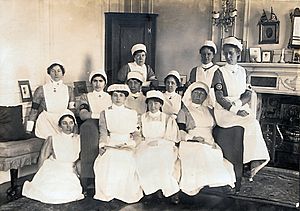
Gertrude Middleton (1876–1942), who became a nurse and a nun, was one of these students. She lived in college housing on Banbury Road.
The Society of Home-Students was also involved in social work. Charlotte Green, an early leader, wanted to help working people. This focus on helping others was a key part of the college's early mission.
In 1910, the University of Oxford officially recognized the Society of Oxford Home-Students. A few years later, in 1912, the society hired its first teachers for German, History, and English Literature. By the 1920s, the leaders of the women's societies were the first women to earn degrees from the university. The college started building its first main building, Hartland House, in 1937.
Becoming St Anne's Society (1942–1952)
In 1942, the Society of Oxford Home-Students changed its name to the St Anne's Society. It also received its own coat of arms. The name "St Anne's" was chosen because there used to be a chapel dedicated to Saint Anne at the University Church. Students would gather there for services.
St Anne's College Today (1952 onwards)
In 1952, the St Anne's Society officially became St Anne's College. In 1959, it gained full college status, just like the other women's colleges. The Principal at the time, Mary Ogilvie, wanted a large dining hall for all students. This led to the building of the dining hall in 1959, which Queen Elizabeth II visited in 1960.
As more students joined, the college needed more places for them to live. This led to the construction of the Wolfson and Rayne buildings in the 1960s. In 1977, the college decided to welcome both male and female students. The first male undergraduate students joined in 1979.
Even though men now study at St Anne's, the college still uses female words like "alumnae" (which means former female students) to refer to all past students. This is a special tradition that shows the college's history.
In 2023, work began to rebuild some of the student housing on Bevington Road. This project aims to make the buildings better for future students.
The Ship Magazine
The Ship is a magazine published every year for people who used to study at St Anne's College. The college's first common room (a shared social space) was on Ship Street in Oxford, which is how the magazine got its name. The Ship started around 1910 and has been published regularly ever since.
College Location and Buildings
College Grounds
The college grounds are surrounded by Woodstock Road to the west, Banbury Road to the east, and Bevington Road to the north. All of the college's main buildings are here. This includes offices, classrooms, student housing, and the dining hall, which is one of the biggest in Oxford.
The college used to own many houses around Oxford for student housing. Many of these were sold to help pay for the Ruth Deech Building, which was finished in 2005.
Student Accommodation
St Anne's can provide housing for undergraduate students for three years of their studies. Students live in 14 old Victorian houses and four newer, purpose-built accommodation blocks. The college also has housing for some of its graduate students. All undergraduate students pay the same amount for their rooms and have access to a shared kitchen in their building.
Victorian Houses
The college uses houses on Bevington Road (often called "the Bevs"), Woodstock Road, and Banbury Road for undergraduate housing. These are usually for first-year students. The student mail room is in 10 Bevington Road, and the college laundry is in 58/60 Woodstock Road. The college bar, which has a pool room, is in 39/41 Banbury Road. Other Victorian houses are used for teaching rooms, meeting rooms, music practice rooms, and college offices. The Bevington Road houses started a two-year renovation project in July 2023.
Rayne and Wolfson Buildings
The Rayne and Wolfson Buildings were built in 1964. They look very similar and are considered important historical buildings. They have administrative offices on the ground floor and student rooms above.
Claire Palley Building
The Claire Palley Building was finished in 1992 and is named after Claire Palley, a former Principal. This was the first accommodation block to have en-suite bathrooms in the rooms. It also contains the Mary Ogilvie Lecture Theatre.
Trenaman House

Trenaman House, built in 1995, has student rooms and shared college facilities. These include the gym and, since 2008, St Anne's Coffee Shop (STACS). It was named after Nancy Trenaman, who was the Principal from 1966 to 1984.
Ruth Deech Building
The Ruth Deech Building, named after a Principal from 1991 to 2004, was completed in 2005. It has a lecture theatre, seminar rooms, dining areas, and a new Porter's Lodge (the main entrance and reception area). It also has 110 student rooms, each with its own bathroom. A special feature is a glass lift that goes above the roof. This building won an award in 2007 for being environmentally friendly.
Robert Saunders House
Robert Saunders House, built in 1996, provides 80 rooms for graduate students. It is located in Summertown, a different part of Oxford. It was named after a former college bursar who helped improve the college's finances.
Eleanor Plumer House
Eleanor Plumer House is named after Eleanor Plumer, a Principal from 1940 to 1953. It houses the Middle Common Room, which is a common room for graduate students. It has a study area, computer room, and kitchen. Some graduate students also live here.
Hartland House
Hartland House was the first building specifically built for the college. It was finished in 1937, with another part added in 1973. It contains the old library, common rooms for students and staff, and administrative offices. You can see the college's crest and carvings of beavers (the college mascot) above the main entrance.
Dining Hall
The Dining Hall, built in 1959, is one of the largest in Oxford and can seat 300 people. Meals are served here every day except weekends, when only brunch is available. The hall is also used for college exams and sometimes for college parties.
College Library
The college library has over 100,000 books, making it one of the biggest in Oxford. It is split between the original library in Hartland House and the newer Tim Gardam Building.
The original library in Hartland House now holds books on law, arts, and humanities.
The new library and academic center is named after Tim Gardam, who was Principal from 2004 to 2016. It was completed in 2016. This new center offers various study and seminar spaces and shelves for the college's growing book collection. The building's design was inspired by Oxford's historic architecture.
The Tim Gardam Building also has two gardens: a roof garden that looks over the dining hall, and a sunken courtyard that you can reach from the basement.
College Traditions
St Anne's College has fewer traditions than some other Oxford colleges. It is also one of the few Oxford colleges that does not have a chapel, as it has a non-religious outlook. Formal hall (a special dinner) is usually held every two weeks. Students do not usually wear academic gowns except for official university events like matriculation (the ceremony to become a university member) and certain college feasts. The college mascot has been a beaver since 1913.
College Grace
The college grace (a short prayer or blessing before a meal) was written by Margaret Hubbard, a former teacher. The Principal says the Latin words Quas decet, (Deo) gratias agamus. Amen. This means "For what we have received, we give thanks (to God). Amen." The word Deo (to God) is included only if the grace is religious.
Room Ballot
The college uses a "room ballot" to decide which rooms students get, except for first-year students. Students entering their fourth year choose their rooms first, then third-year students, and finally second-year students. Students are given a number within their year, which determines their turn to pick a room. For first-year students, this number is based on the quality of their room from the previous year. For second-year students, numbers are drawn randomly.
In the past, students would line up, and rooms were chosen one by one from a big board. Now, the room ballot happens online. Students are given a week after the ballot to swap rooms with each other if they agree. Unlike many colleges, students who are part of the Junior Common Room (JCR) or Middle Common Room (MCR) committees do not get any special advantage in choosing rooms.
Sport and Societies
The college has teams for all major sports. They compete in "Cuppers" tournaments, which are competitions between different colleges. Games are played either in the nearby University Parks or on the college's own playing fields on Woodstock Road.
The St Anne's College Boat Club (SABC) organizes the college's rowing activities. The college's boathouse, located on the River Isis, is shared with St Hugh's and Wadham colleges.
St Anne's has a joint rugby team with St John's College, which won the Cuppers tournament in 2014. The women's football team, also joint with St John's, won Cuppers in 2020. The St Anne's men's football team, known as the Mint Green Army, won the Hassan's Cup plate tournament in 2018.
Notable People
Former Students
-
Sir Danny Alexander, former government minister
-
Helen Fielding, creator of Bridget Jones
-
Mr Hudson, rapper and R&B artist
-
Penelope Lively, award-winning author
-
Sir Simon Rattle, famous orchestra conductor
-
Martha Kearney, journalist and broadcaster
As a former women's college, St Anne's still calls all its former students, both female and male, alumnae.
- Sir Danny Alexander (born 1972), a politician.
- Karen Armstrong (born 1944), an author.
- Tina Brown (born 1953), a well-known magazine editor.
- Helen Fielding (born 1958), a novelist.
- Jacob Fortune-Lloyd (born 1988), an actor.
- Diana Wynne Jones (1934–2011), an author of children's books like Howl's Moving Castle.
- Martha Kearney (born 1957), a journalist and broadcaster.
- Penelope Lively (born 1933), a novelist and children's writer.
- Benjamin Hudson McIldowie, (born 1979), a rapper and R&B artist known as "Mr Hudson".
- Sir Simon Rattle (born 1955), a famous conductor.
- John Robins (born 1982), a comedian and radio presenter.
- Polly Toynbee (born 1946), a journalist and writer.
- Victor Ubogu (born 1964), a rugby player.
Academics
- William MacAskill (born 1987), a philosopher who helped start the effective altruism movement.
- Ruth Deech, Baroness Deech (born 1943), an expert in law.
- Peter Donnelly (born 1959), a mathematician.
- Georg Gottlob (born 1956), a computer scientist.
- A. C. Grayling (born 1949), a philosopher.
- Iris Murdoch (1919–1999), a famous writer.
- Merze Tate (1905–1996), a historian, and the first African-American woman student at Oxford University.
Images for kids


